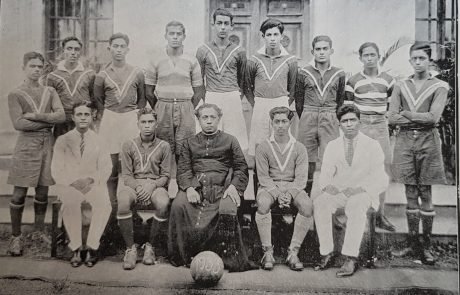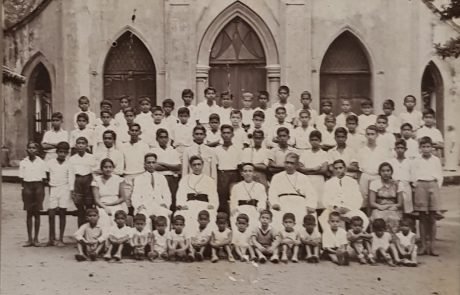The 2nd Decade (1932 – 1941)
While ensuring that the physical infrastructure was available for the College to move forward, from an educational point of view in order to accommodate increasing numbers of students, in a far thinking move, on 13th January 1932, Fr. Nicholas Perera established a separate Primary Department, under Rev. Fr. D Gregory Goonawardene who was appointed Principal.
With sports introduced at the earliest stages little wonder St. Peter’s started producing individual sportsmen and teams of repute from early years under Mr. L E Bertus as Prefect of Games.
Although cricket was introduced in 1927 with Norman Paternott as captain, it was limited to a few friendly games and on the 15th of January 1929, Herbert E Wittahatchy joined the tutorial staff of St Peter’s College and succeeded Mr. Bertus as the Prefect of Games in 1932. While being a dedicated member of staff, after classes he was coach for cricket, football and athletics, not to mention rugby which was also introduced in 1932. It is said that Rugby commenced at St. Peter’s largely due to Mr. Wittachchy’s enthusiasm, a game to which the boys had taken like ducks to water.
Despite the reluctance on the part of established schools to give sporting fixtures to the Peterites, it is known that Mr. Wittachchy is the one who managed to persuade some of the older, more established schools to give St Peter’s sports fixtures and the first cricket match of note was played in 1932 against St. Benedict’s College, Fr. Nicholas Perera’s old school. Captained by George Jayaweera the Peterite cricketers won the match.
The first Rugby match was also played in 1932 which was against Royal College. The first Peterite rugby captain was Lim F Bilimoria and although the match was lost, it was the start of a successful sport at the College.
Making 1932 a sports filled year Volleyball was also introduced at St. Peter’s in that year.
On 1st February 1933 the House System was introduced with 4 Houses created. These were: Anthony House – named after the Archbishop at the time the school was started, Most Rev. Dr. Anthony Coudert; Peter House – named after the Archbishop at the time the house system was started, Most Rev. Dr. Peter Marque; Maurice House – named after Rev. Fr. Maurice Le Goc, the Founding Rector and Nicholas House – named after the first Rector of St. Peter’s, Rev. Fr. Nicholas Perera.
On 23rd and 24th February 1933 the first ever Big Match (Josephian-Peterite) was played at the St. Peter’s College Grounds. The Peterite captain was George Jayaweera. The Josephians being the more experienced team the Peterites lost the match by an innings and 105 runs.
In 1934 on the 6th of May the Dental Institute, a gift from Mr. James P Fernando, was opened by the Minister of Education, Mr. C W W Kannangara and St. Peter’s became only the 3rd school to boast of a dental institute within the school premises.
Also in 1934, 13th July to be precise, a Rifle Club was inaugurated with the participation of the Cadet Platoon but more important for sports was the fact that for the first time and only four years after athletics started in earnest with the opening of the Peterite grounds, St. Peter’s won the Tarbet Challenge Cup and tied for the Jefferson Cup at the schools athletics meet held on 13th and 14th of October 1934.
1937, December 7th saw new Priests’ Quarters and Classrooms opened by H.E. Sir Andrew Caldecot KCMG, Governor of Ceylon who later inspected the Cadet troop and was Chief Guest at the Prize giving.
If one were to say that providing infrastructure and promoting sports were prominent in Fr. Nicholas Perera’s mind, one could say education was foremost in his mind. He is said to have had almost a paternal interest in most of his students, guiding them and encouraging them to reach beyond the limited lines of vision they would have set for themselves. Having joined the school in the year it commenced (1922), upon completing his College education, P R Anthonis, when he entered the University along with a fellow student L J D Fernando, had proven that this school had nothing but greatness written over it and was going to be a force to be reckoned with among educational institutes.
With World War II raging in Europe, the Middle East and in Asia, the Government of the day, requisitioned St. Peter’s College premises to be used as a hospital for the Royal Navy in 1938 and the College split to operate from three different locations, i.e. Minuwangoda, Dehiwela and Milagiriya (where the Bambalapitiya Flats stand now).
Fr. Nicholas Perera who was perhaps the only Ceylonese Rector in a Catholic school in that era when most were of foreign origin, earned the name ‘Giant in Education’ for the pioneering work done at St. Peter’s. His monumental contribution to education was such that at his retirement the public entertained him to a dinner at the Galle Face Hotel, presided over by Mr. D S Senanayake, the leader of the State Council and he was the first Catholic Priest to be so honoured.
Our History





























